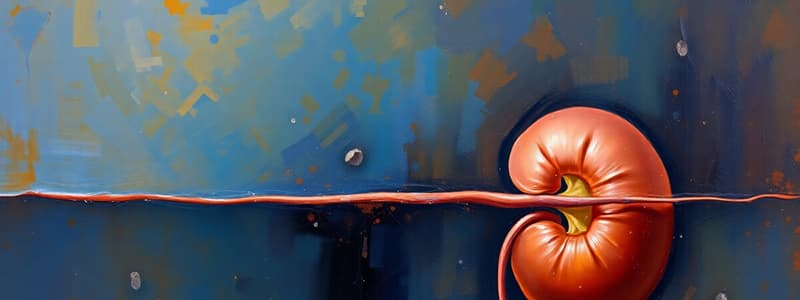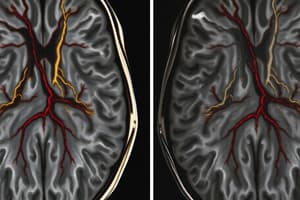Podcast
Questions and Answers
The osmolality of the interstitial fluid in the renal ______ increases progressively from 300mOsm to 1200mOsm.
The osmolality of the interstitial fluid in the renal ______ increases progressively from 300mOsm to 1200mOsm.
medulla
A(n) ______ loop establishes the medullary osmotic gradient in the nephron.
A(n) ______ loop establishes the medullary osmotic gradient in the nephron.
nephron
The ______ limb of the loop of Henle is permeable to water but not to salt, while the ascending limb is impermeable to water but actively transports salt.
The ______ limb of the loop of Henle is permeable to water but not to salt, while the ascending limb is impermeable to water but actively transports salt.
descending
Filtrate becomes more ______ as water leaves in the descending loop and then diluted as Na+ and Cl- are pumped out of the ascending loop.
Filtrate becomes more ______ as water leaves in the descending loop and then diluted as Na+ and Cl- are pumped out of the ascending loop.
[Blank] concentration increases along the nephron and is high in the collecting duct, contributing to the osmotic gradient.
[Blank] concentration increases along the nephron and is high in the collecting duct, contributing to the osmotic gradient.
The vasa ______ acts as a countercurrent exchanger to maintain the medullary gradient.
The vasa ______ acts as a countercurrent exchanger to maintain the medullary gradient.
Without a ______, urine would always be dilute and large in volume, and the body wouldn't be able to conserve water.
Without a ______, urine would always be dilute and large in volume, and the body wouldn't be able to conserve water.
[Blank] increases water channels in the collecting duct.
[Blank] increases water channels in the collecting duct.
[Blank] promotes renal vasodilation which will increase GFR.
[Blank] promotes renal vasodilation which will increase GFR.
An ADH effect of ______ aquaporin collecting ducts.
An ADH effect of ______ aquaporin collecting ducts.
[Blank] hormone increase in release from the posterior pituituary during dehydration.
[Blank] hormone increase in release from the posterior pituituary during dehydration.
A lack of water channels in the ______ allows for a dilute urine.
A lack of water channels in the ______ allows for a dilute urine.
The ______ from the atruim of the heart is relased during cases of high blood pressure.
The ______ from the atruim of the heart is relased during cases of high blood pressure.
[Blank] acts directly on collecting ducts to increase sodium reabsorption.
[Blank] acts directly on collecting ducts to increase sodium reabsorption.
Contraction of the ______ muscle is a ______ process.
Contraction of the ______ muscle is a ______ process.
A ______ is an agent that increases urinary output.
A ______ is an agent that increases urinary output.
Consuming ______ will inhibit the effects of ADH.
Consuming ______ will inhibit the effects of ADH.
Actively using the bathroom requires the ______ of the internal sphincter.
Actively using the bathroom requires the ______ of the internal sphincter.
Collecting ducts ______ the gradient.
Collecting ducts ______ the gradient.
The ______ of urea increases along the nephron, high in the collecting duct.
The ______ of urea increases along the nephron, high in the collecting duct.
Flashcards
Medullary Osmotic Gradient
Medullary Osmotic Gradient
The osmolality of the interstitial fluid in the renal medulla increases from 300 mOsm to 1200 mOsm.
Osmolality
Osmolality
The concentration of solutes in a fluid.
Countercurrent Multiplication
Countercurrent Multiplication
A process where the nephron establishes the medullary osmotic gradient, creating concentrated or dilute urine.
Descending Limb Permeability
Descending Limb Permeability
Signup and view all the flashcards
Ascending Limb Permeability
Ascending Limb Permeability
Signup and view all the flashcards
Urea
Urea
Signup and view all the flashcards
Vasa Recta Function
Vasa Recta Function
Signup and view all the flashcards
ADH (Antidiuretic Hormone)
ADH (Antidiuretic Hormone)
Signup and view all the flashcards
Concentrated Urine
Concentrated Urine
Signup and view all the flashcards
Dilute Urine
Dilute Urine
Signup and view all the flashcards
Why Osmotic Gradient Matters
Why Osmotic Gradient Matters
Signup and view all the flashcards
ANP (Atrial Natriuretic Peptide)
ANP (Atrial Natriuretic Peptide)
Signup and view all the flashcards
Micturition
Micturition
Signup and view all the flashcards
Diuretics
Diuretics
Signup and view all the flashcards
How does the nephron operate via countercurrent multiplication to produce concentrated and dilute urine?
How does the nephron operate via countercurrent multiplication to produce concentrated and dilute urine?
Signup and view all the flashcards
What Urea is and its role in urine concentration
What Urea is and its role in urine concentration
Signup and view all the flashcards
Role of vasa recta in allowing nephron to concentrate urine
Role of vasa recta in allowing nephron to concentrate urine
Signup and view all the flashcards
Micturtion
Micturtion
Signup and view all the flashcards
Study Notes
- Lecture on Renal structure and function
- The goal of the lecture is to understand how the nephron operates to produce concentrated and dilute urine
- It is also about understanding what role hormones play in this process
Medullary Osmotic Gradient
- Osmolality of interstitial fluid increases from 300 - 1200 mOsm from the cortex to the medulla
Osmolality Definition
- Osmolality details the concentration of solutes in a fluid
Osmolality Calculation
- Osmolality = Amount of solutes / Amount of fluid
Osmolality Examples
- High osmolality means high solute concentration and less fluid, resulting in concentrated urine
- Low osmolality means low solute concentration and more fluid, resulting in diluted urine
Countercurrent Multiplication
- Countercurrent multiplication establishes the body's medullary osmotic gradient
- Filtrate flows via countercurrent through two parallel sections of nephron loop
- The descending limb is permeable to water, but not salt, where only water leaves
- The ascending limb is impermeable to water but pumps out salt
- Filtrate is more concentrated as water leaves descending loop
- Filtrate is more diluted as sodium and chloride are pumped out of ascending loop
Urea Recycling
- Urea is a common waste product from breakdown of proteins that contributes to osmotic pressure
- Urea concentration increases along the nephron with high concentration in the collecting duct
- This urea diffuses out of the collecting duct into the medulla which contributes to the medullary osmotic gradient
- It is then recycled back into the nephron loop up to 6 times
Vasa Recta
- Vasa recta acts as a countercurrent exchanger, exchanging H2O and solutes
- As blood moves down, H2O will leave and solutes will enter vasa recta
- As blood moves up, solutes leave and H2O will enter the vasa recta, resulting in a 1:1 ratio
- There is no net loss or gain of water or solutes
- The medullary gradient is maintained
Osmotic Gradient Importance
- Nephron loops create gradient
- Urea recycling contributes to the gradient
- Vasa recta preserves and maintains the gradient
- Collecting ducts use & allows the kidneys to vary urine concentration dramatically
- The Kidneys regulate body water levels
- Without the gradient, urine would always be diluted and large in volume because the body would not he able to conserve H2O
ADH Concentrated Urine
- Antidiuretic Hormone (ADH) results in anti-urinating and less water, and is as a result of dehydration
- This results in an increase in the number of aquaporin water channels in collecting duct
- There is also increased H2O reabsorption from collective duct back into blood
- A small volume of concentrated urine is peed out
- The body is reabsorbing water
ADH Dilute Urine
- Antidiuretic Hormone (ADH) decreases with overhydration
- There are a lack of water channels in the collecting duct
- The H2O stays in the collecting duct and large volumes of dilute urine are created
ANP Dilute Urine
- Atrial Natriuretic Peptide (ANP) is released because of high blood pressure
- ANP is released from the atrium of the heart
- ANP suppresses ADH release
- ANP acts directly on the collecting duct to decrease Na+ which results in the decrease reabsorption of water
- This increased volume of dilute urine brings down blood volume and blood pressure
Micturition
- Micturition is urination
- This involves emptying the urinary bladder through the mechanism of action
- Micturition involves the contraction of the detrusor muscle which is parasympathetic
- This involves relaxation of the internal sphincter which is parasympathetic
- Also relaxation of the external sphincter which is somatic allows for conscious control
Diuretics
- Diuretics enhance urinary output
- Alcohol inhibits ADH
- Caffeine promotes renal vasodilation, which increases GFR
- Pharmaceuticals inhibit Na+ reabsorption
Studying That Suits You
Use AI to generate personalized quizzes and flashcards to suit your learning preferences.




